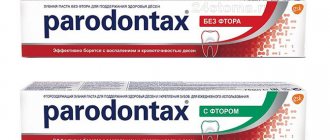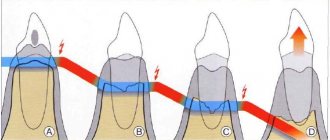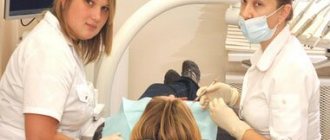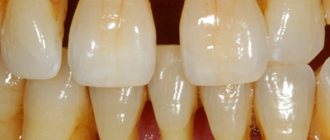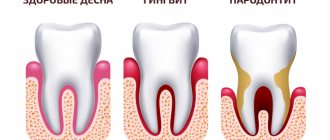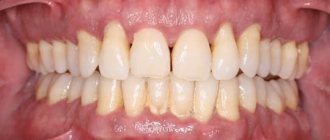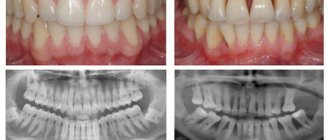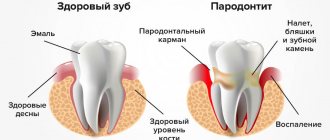Introduction
The information world is very huge. Each of us is haunted by a million points of view
for any problem in any field of knowledge, you just need to ask a search query. The same thing happens in medical circles on the Internet - discussions of health problems are widely represented by both patients and doctors and often reach the point of absurdity:
For example, in questions:
- loosening of the tooth,
- exposure of the neck of the tooth,
- why are my gums and teeth exposed?
that is, in situations where the gums on a tooth have receded, patients are always confused: either they have periodontal disease
, then suddenly it changed to
periodontitis
, then periodontal disease returned again. And the search for an answer to the question becomes endless.
The problem of “how to treat periodontal disease” is picked up by doctors who only add fuel to the fire by recommending medications and even folk remedies for periodontal disease, without having sufficient competence to do so.
Let's consider these points of view professionally, and try to convey one simple truth, which for the vast majority of patients (and even some doctors) will be a revelation: the diagnosis of periodontal disease of the gums
» —
does not exist
.
An expert point of view is expressed by the famous periodontist, Doctor of Medical Sciences Laura Mikhailovna Tebloeva:
As a rule, for patients who come to me and say: “I have periodontal disease,” I always clarify - did you make this diagnosis yourself or did you see a doctor? Often patients answer that they have this information from their doctor. It turns out that the patient did not read somewhere and determine the diagnosis of “periodontal disease” for himself, but, unfortunately, such a diagnosis was made by a doctor.
Symptoms
The onset of the disease is characterized by a gradual weakening of the bone structure of the dental alveoli and ultimately their atrophy. On an x-ray image, the bone marrow spaces are recorded to be reduced in size, the bone is displayed with a fine-mesh structure, there is less bone tissue between the teeth, and pockets of osteoporosis are observed.
With the appearance of disorders in bone tissue, changes in the gums begin to be recorded. They weaken, become thinner and droop, thereby exposing the roots of the teeth. Against this background, the sensitivity of teeth to temperature and chemical exposure increases.
The general course of the disease is characterized by the following symptoms:
- A slight plaque forms on the teeth.
- The tooth necks become exposed and painful sensitivity appears within the problem areas.
- The gums become pale and begin to itch.
- The tooth necks are exposed, but there is no inflammatory process, gum pockets do not appear, and therefore pus does not accumulate in them.
Attention! The development of periodontal disease occurs very slowly and does not manifest itself at the 1st stage. Based on symptoms, doctors divide the disease into 3 degrees:
- First degree. Has no symptoms. Destruction of periodontal tissues is observed. In this case, discomfort and pain are not felt by the person.
- Second degree. The teeth gradually shift. The neck of the teeth begins to be visible through the depleted gums. The gap between the teeth becomes wider. Painful sensitivity to any irritants appears.
- Third degree. Teeth lose stability, become shaky, and begin to fall out. The patient “goes” to this stage for about 15 years.
Modern effective treatment methods suggest that timely treatment of a disease such as periodontal disease produces positive results.
Always treat gum problems
When a patient comes to the doctor, he complains about something. What symptoms does he see a doctor with before receiving a diagnosis of periodontal disease? What worries him?
Literally, patients tell the doctor this: my gums have sagged, my gums have become exposed, my lower gums have receded. And for some reason the symptom of gum subsidence automatically means that the patient has the so-called. periodontal disease.
More experienced patients, who have already heard a lot of professional terms, who delve into the professional colloquial language of doctors, say this: “The necks of the teeth have become exposed a little, the teeth have become a little higher.” But, according to statistics, most patients complain about sagging gums.
And so, when patients come to the doctor with complaints about the problem of exposed tooth necks, the doctor diagnoses them with periodontal disease. Of course, he begins to treat them. And to treat it specifically for periodontal disease.
But time passes, money also goes away, and the question of why the gums recede and the necks of the teeth become exposed, why the gums recede, has not been resolved. And the patient still has periodontal disease.
Causes of periodontal disease
Most often, there are several reasons for the appearance of the disease, one of which is a violation of metabolic processes in the patient’s body. In addition, there are a number of reasons that usually go in parallel with periodontal disease:
- diseases of the gastrointestinal tract;
- hormonal imbalance, disruption of the endocrine system;
- bite pathology;
- the presence of bad habits such as smoking cigarettes and excessive alcohol consumption;
- decreased immunity;
- lack of vitamins and nutrients;
- atherosclerosis, high blood pressure;
- a history of diabetes mellitus;
- hereditary factor;
- the presence of plaque of natural origin.
Symptoms of periodontal disease
According to statistics, patients do not know about the onset of the disease, since at first it goes unnoticed. But during a dental examination, patients complain of:
- painful reaction to hot, cold, sour;
- constant bleeding gums, bloody taste throughout the day;
- swelling and soreness of the gums;
- a putrid odor from the mouth is noticed immediately after brushing;
- emerging tooth mobility.
What tactics are used to treat periodontal disease?
I want to start with the fact that patients who come with a diagnosis of periodontal disease, they need, every single one, treatment... not from the periodontist to whom they initially turned.
If we talk about the tactics of managing patients with the so-called. periodontal disease, which then come to me again, it’s a shame to voice this, but the treatment of periodontal disease was carried out right up to injections of Lincomycin into the exposed gum.
According to statistics, almost always the treatment of periodontal disease in adults with medications is burdened with a course of some antibiotics and physical therapy.
And most importantly, the task of all these manipulations is completely unclear: what do doctors want to achieve in this way, to destroy some kind of flora or to stop some destructive processes in the gums? It is very difficult for me to say what happens to the competence of a doctor who injects antibiotics for the so-called. periodontal disease, but this is absolute blasphemy. Is it possible to cure periodontal disease by destroying the flora? As a result, the gums will never recover.
Treatment of gum periodontal disease reaches the point of absurdity
I would like to note the widest range of drugs and folk remedies that patients use to attempt self-treatment of periodontal disease at home. Among the folk remedies, one can note the treatment of periodontal disease with hydrogen peroxide, and even treatment with soda:
What about the use of various toothpastes for periodontal disease? What goals do patients have? The purpose of toothpaste is preventative, not curative. And no toothpaste will eliminate inflammation, because there is no such inflammation in periodontal disease.
It is not difficult to guess that in these combinations of procedures the question of how to cure periodontal disease remains open.
How is periodontal disease treated?
Treatment of periodontal disease
The standard treatment regimen consists of several steps:
- Primary examination by a dentist - visual identification of the problem, assessment of the general condition of the oral cavity.
- Sight X-ray or panoramic computed tomography of the jaw.
- Cleaning from plaque and stone, treatment of associated diseases, including caries.
- Removal of dead tissue from the periodontal area.
- If necessary, splinting teeth to reduce mobility.
- If the tooth cannot be saved, it is removed, and prosthetics are prescribed several months after final recovery.
In addition to office procedures, a long course of medication is prescribed, which includes:
- Methyluracil - accelerates the regeneration of affected tissues.
- Lidaza – improves blood circulation in the gums.
- FiBS – fights inflammatory processes in tissues.
- Multivitamin complexes intramuscularly - for general strengthening of the body.
In cases where tissue infection has begun against the background of periodontal disease, it is necessary to take antibiotics. They are selected individually, both the drug itself and the dosage. Some medications are administered by injection to speed up the healing process as much as possible.
During therapy, ordinary pharmacy rinses will not help. It is better to replace them with an antiseptic decoction of chamomile, blackberry leaves or calendula. You can rinse your mouth with it almost without restrictions after every meal.
There is no inflammation with periodontal disease
When does the so-called periodontal disease, there is no inflammatory process in the gums. The clinical picture of “periodontal disease” differs sharply from periodontitis; it is with periodontitis of the tooth that inflammation occurs.
And injections into the gums, endless restorations of the necks of the gums - this is running in circles. Over time, again all the restoration fillings are chipped, and again these patients come to have these fillings restored again. And this happens endlessly
:
And the diagnosis of “periodontal disease” does not go away. As Desna ran away, she continues to leave. The fillings increase, that is, the teeth increase in size, because the gums sag more and more, and nothing useful happens.
When such a patient gets an appointment with me, unwinding his entire tangle of ordeals during the consultation, it becomes clear that all previously performed gum treatment consists of 3
factors:
- Lost time,
- lost money
- shattered hopes.
The diagnosis was incorrect and the treatment was appropriate for the incorrect diagnosis. What went wrong?
Patients should always go for a consultation with such a diagnosis... to an orthodontist
.
Because periodontal disease is an occlusal injury
.
What I see in these patients with signs of periodontal disease is a completely different diagnosis. This is an occlusal injury that can only be corrected by an orthodontist.
What contributes to the development of the disease?
Unlike periodontitis, gum periodontal disease is a systemic disease. It is not caused by poor oral hygiene or inflammation, like periodontitis.
Dental periodontal disease is associated with:
- hereditary predisposition;
- sudden hormonal imbalance;
- severe, prolonged stress;
- gastrointestinal diseases;
- atherosclerosis, hypertension;
- with diabetes mellitus;
- weakened immune system;
- HIV infection;
- smoking, chewing tobacco.
What is occlusal injury
Occlusal trauma is when a tooth experiences excessive stress due to:
- the tooth is not in the dentition,
- the tooth is not in the correct position,
- the tooth has not grown physiologically,
- the tooth is tilted, at the wrong angle.
The occlusion of the teeth is impaired. That is, when chewing in a patient with impaired occlusion, a destructive force of chewing pressure is created, and the bone tissue in the area of these above teeth begins to decrease.
What is chewing from a physiological point of view?
It's teeth hitting teeth. The strongest blow, since the masticatory muscles are the strongest in the body.
In simple words, in a patient, from such a hyper-impact, hyper-contraction of the masticatory muscles, which develops during chewing, from this beating of teeth against each other, the bone begins to contract. Bone tissue shrinks. And after the bone, the gum also contracts, because the bone and gum are tightly connected. The gum descends, following the bone. And here we answered the main question - why gums recede.
Let's now begin to form an understanding of the answer to the next question: what to do if your gums have receded.
Toothpastes
You can also cure periodontal disease at home using special toothpastes with an anti-periodontal effect. Unlike conventional dental hygiene products, medicinal pastes contain antimicrobial components, minerals and plant extracts. They have a beneficial effect on the condition of the gums, improve blood microcirculation, relieve inflammation, and stimulate periodontal renewal.
Medicinal toothpastes for the treatment of diseases:
- LACALUT Active
- PRESIDent Active
- Splat Green tea
- Parodontax
- Forest balm
- Parodontol Active
You should use medicated toothpastes only after consulting your dentist. They are used to brush your teeth twice a day for 3 minutes using massage toothbrushes. Courses of treatment last 30-60 days with breaks between them of 2-3 months.
Orthodontics comes to the fore
Today, a huge mistake is happening both in the search for the causes of periodontal disease and in making a diagnosis, as well as in the method of effective treatment. Instead of putting the tooth into occlusion, removing it from a traumatic bite, patients are offered all these manipulations that I have previously voiced, which are not at all aimed at getting rid of these complaints, but only at the fact that patients are wasting time, the processes are getting worse.
In the treatment of the so-called periodontal disease is a big problem in the loss of time for inadequate treatment, and the loss of time for the patient is a complication of the pathology of dental occlusion, and the transition of the stage of the disease to a more advanced form.
If a patient, for example, three years ago had a loss of bone tissue of two millimeters, then due to the “treatment of periodontal disease” he has already lost five millimeters, that is, we have lost time.
And if he came to the orthodontist with a loss of bone tissue of two millimeters, then it would be easier to stop the loss of gums, it would be easier to eliminate the development of gum pathology after orthodontic treatment, when the teeth become aligned with the dentition.
We can already talk about the fact that we close all exposed necks of gum recession, thereby treating the neck of the tooth. But when patients waste time on treatments that are inadequate for the disease, sometimes closing the recession is no longer possible. Because there are also strict indications and contraindications for the treatment of gum recession.
Gel
A good effect in treating periodontal disease at home is provided by the use of gels that increase blood supply to the gums, have an anti-inflammatory effect, and also have a pronounced trophic effect.
Troxevasin
Troxevasin gel has an anti-periodontal effect by strengthening the vascular wall in the capillaries of the gums, improving blood supply to tissues, and enhancing metabolic processes in cells.
Using gentle massage movements, rub the gel into the gums until it is completely absorbed. The procedure should be repeated twice a day after regular hygienic brushing of teeth. The course of treatment is 30 days.
Biodent gel
The gel contains calcium hydroxyapatite, a substance that helps restore tooth tissue and also prevents the deposition of hard plaque. Biodent gel also contains chlorhexidine, a powerful antiseptic that eliminates inflammation in the periodontium. The action of the active components of the gel is complemented by calamus root extract, which improves the trophism of the tissues around the tooth and restores impaired blood circulation.
Biodent gel is recommended to be used twice a day after meals and mechanical brushing of teeth. The drug is applied to the teeth and gums with massaging movements using a toothbrush with soft bristles for 5-7 minutes. There is no need to rinse your mouth after the procedure. You should also refrain from eating, drinking and smoking for 30 minutes. Courses of treatment lasting 2-3 weeks are carried out regularly, with breaks between them of 3-4 weeks.
Elugel
The active ingredient of the drug is chlorhexidine. It has an antimicrobial effect, relieves inflammation of the gums and tissues surrounding the tooth.
The gel is applied in a thin layer to the affected gums 3-4 times a day. The duration of therapy depends on the severity of periodontal disease and averages 2 weeks.
Elgifluor
Elgifluor teeth cleaning gel contains fluorinol and chlorhexidine digluconate, which have a bacteriostatic effect, prevent the deposition of tartar and suppress inflammation in the tissues surrounding the teeth.
Elgifluor is applied to a toothbrush and cleanses the surface of the teeth and gums for 3-4 minutes. Repeat the procedure 3 times a day until the signs of the disease completely disappear.
Holisal
Cholisal gel has a powerful anti-inflammatory effect. improves nutrition of periodontal tissues, has an antibacterial effect.
To treat periodontal disease, the gel is injected into the gum pockets or rubbed into the gums twice a day. For adults, 1 cm of the drug is enough. The duration of treatment is individual and depends on the speed of disappearance of the clinical manifestations of the disease.
Other methods for treating gums at home
- Oral baths with decoctions and tinctures, which include Kalanchoe, chamomile, St. John's wort, calendula and other anti-inflammatory herbs and extracts.
- Special diet - just increase the number of foods that contain a large amount of calcium (cheese cheese, cottage cheese, beans, almonds, etc.) and vitamin C (orange, kiwi, strawberries, black currants, etc.).
- To give up smoking. Cigarettes worsen the condition of teeth and gums and provoke the development of inflammation.
Home methods for treating gums bring good results, but they can never replace full-fledged dental treatment.
How to properly rinse your mouth with saline solution
To prepare the solution you need 1 – 2 teaspoons of salt and a glass of boiled water. However, there are a number of subtleties that need to be taken into account.
- Before rinsing, you should brush your teeth.
- The solution should be warm. Hot can burn the mucous membrane, and cold can increase the pain.
- It is recommended to rinse your mouth after every meal.
- After using the saline solution, you do not need to rinse your mouth with water. If there is a need, you should wait at least 5 minutes.
Despite its effectiveness, the salt solution is not an alternative to professional treatment. If you have any problems with your gums, we recommend that you consult a doctor.
Remember that the health of your teeth depends on the condition of your gums, so try not to delay your visit for too long. You can make an appointment with our doctors right now: 220-86-30
Why does salt help?
Salt is considered one of the most effective methods for treating periodontal disease. It stimulates the restoration of periodontal tissue and relieves inflammation. The effectiveness of salt is explained by the fact that it has the ability to draw out moisture. Once in the oral cavity, salt “takes” liquid from the inflamed area, thus depriving bacteria and microorganisms of their natural habitat. When treating, it is better to use sea salt, as it is rich in iodine.
Salt rinses
Saline solution is considered one of the most effective methods of treating teeth and gums.
It is often used as a first aid remedy before visiting the dentist. Table 1. Types of salt rinse solutions
| View | Preparation |
| Salt + soda | Suitable for those for whom regular saline solution is not suitable. Mix one teaspoon of baking soda and salt in a glass of water. Can be used after tooth extraction, but carefully so as not to injure the socket. |
| Salt + soda + iodine | 1 tsp salt and soda, 2 - 3 drops of iodine per glass of warm water. |
| Salt + vodka | Add 2 - 3 tbsp to a glass of water. vodka and 1 tsp. salt. Rinse with caution so as not to burn the mucous membrane. |
| Salt + herbal decoctions | Decoction recipes:
|

